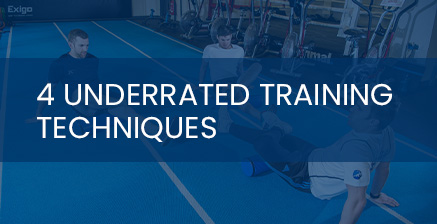With more and more clients looking to train from home, or with a hybrid home/gym programme, it’s important to include exercises within your programmes that can easily be performed at home. That’s why we wanted to share with you our 4 underrated training techniques that we think you should be implementing in your programmes and why!
Hill sprints
If you/your client are looking to get leg strength and combine that with endurance and heart aerobic capacity, hill sprints are fantastic! Hill sprints have been a staple part of our coaches programmes but not only for endurance, they’re great for power and acceleration too! Hill sprints can be beneficial for a variety of different athletes, from tennis players to boxers, and even weightlifters. Another great thing about hill sprints is that they can be performed in the gym, as well as outside so you and your athletes can put this training technique into practice at home.
Hill sprints can be performed in a variety of ways, for example; max efforts (10-second hill sprints using a cone to beat the length over the 10 seconds), or slightly longer 30-second sprints up the hill and then a really gradual walk down and recover off the back of that. You can even include them in longer runs, 5K’s with a decent amount of incline in them.
It’s great to try to get people to push at the top of the hill sprint, so they come up the hill and ‘run off’ the top of the hill. It’s a really good underrated modality.
What about weighted Sprints?
Weighted hill sprints would be an option, but you need to have a rationale as to what you are doing them for. Weighted sprints in an upright position with a light vest are shown to be beneficial to some people for maximum speed.
How long and high is should the hill be?
Rather than focusing on the length and incline of the hill, it’s best to perform your timed sprints on a set distance and then a recovery rate of a 3:1 ratio on the hill sprints. For example; 30 seconds up the hill and 90 seconds recovery on the back of that.
This type of training can often get left out of programmes as they can be seen as a bit ‘old school’ and trainers often want to go for something a bit more ‘fashionable’ and ‘on-trend’. However, people have got serious levels of strength, strength endurance, and general endurance from performing hill sprints. A great pre-season way to develop acceleration and power (provided you have the recovery) so they are a good tool!
Press Ups
We know we’re probably preaching to the converted here! Press Ups and push up variations are great! They’re great to build into your programmes as you can include lots of different challenges and ways that you can bring press-ups in but just at its very basic level. The ability for somebody
to go through a full range press up and develop relative body strength with that pushing movement is a beautiful movement. And again, we often remove them in favour of bench presses, dumbbell presses, overhead
presses (all of which have got their place) but as a general conditioning tool and relative strength tool. We cannot speak highly enough of press up and push up variations. Depending on your athlete’s capabilities, a great way to add these into training is to get them to do a number of reps (100 reps for example) in as few sets as possible.
Other great variations include;
Kettlebell press-ups where you go in the extra range using the kettlebell handles.
Judo press-ups where you drop down and go through the shoulders. These are fantastic for mobility, trunk stability, and trunk strength.
Single-Leg Squats
Single-Leg Squats, another one of those that definitely need to be included in more programmes. Unsupported
single-leg squats like pistol squats and supported single-leg squats like split squats, reverse lunge, re-elevated squats are really relevant. These are another one of those exercises that can be performed from anywhere. You/your athletes can do single-leg work anywhere. You can think about what you can do on the tempo side, you can manipulate eccentrics, you can do isometrics in there, you can do pauses or rest pauses in there. You can get an overload effect
through single-leg squats. They do bulletproof your knees and ankles and help identify any mobility challenges you have got when you watch somebody squatting in that way.
Static Stretching
Life has moved on where we want those 40-second mobility fixes and you know what, they’re totally legit! Taping things, ankle mobilisations, hip work – totally, but if you want to change the composition of a fibre, lengthen muscle fibres, or stretch tendons you need to give static stretching more time and more priority in the
programme.
Static stretches can be done against any wall, glutes and abductors, hip flexors, hip work in general against the wall so you can let gravity do its job. Bring static stretching in and keep it in the programme for people that need that increased movement capacity.
If you want to focus on lengthening muscle fibres, then static stretching when you’re warmed up is perfect. If you want to focus on tendon adaptations, then static stretching when cold will preferentially focus on tendons. Nobody is going to get injured if it’s supervised and done correctly but static stretching is not supposed to be comfortable. It will be tough to take.
One of our CEO, Brendan’s mentors Kelvin Giles used to say the “results you’ll get when you static stretch are directly proportional to how much pain you’re prepared to tolerate.”
Ready to get started?
Download our Strength and Conditioning Courses Brochure
